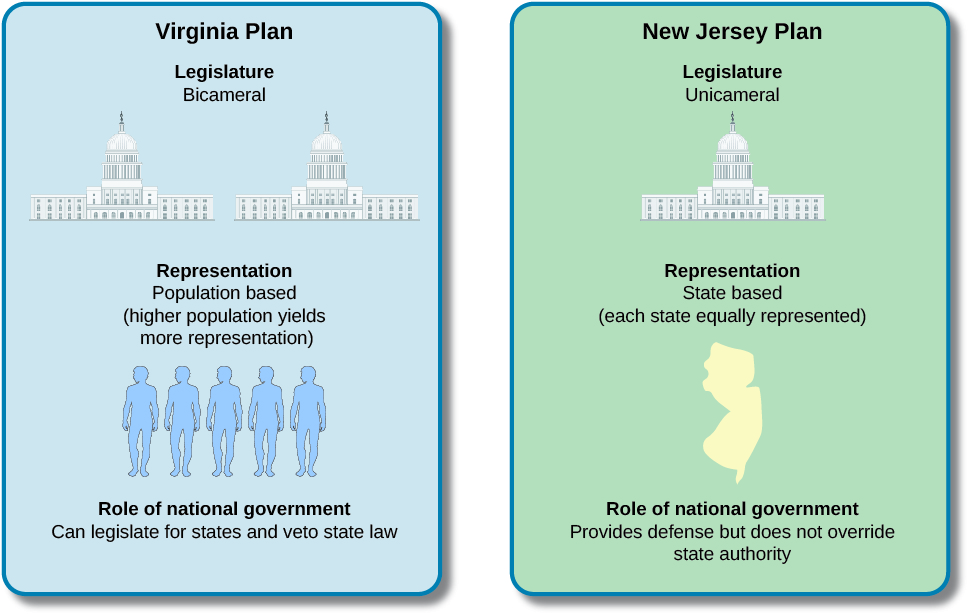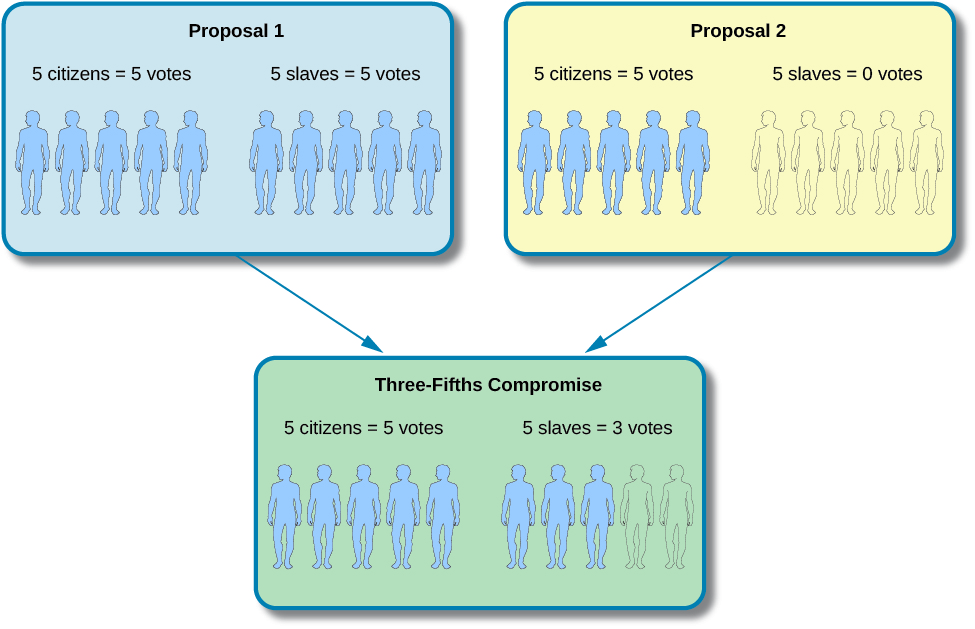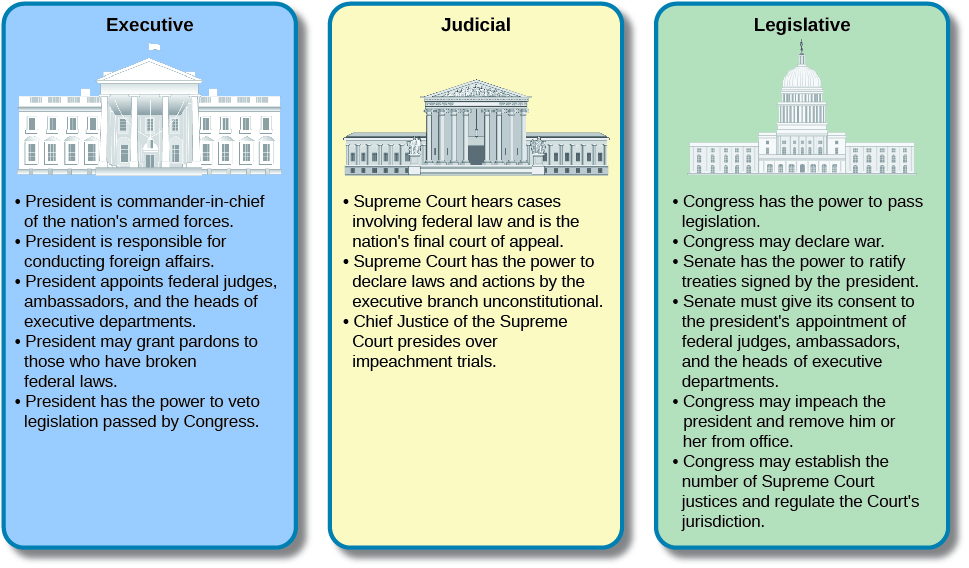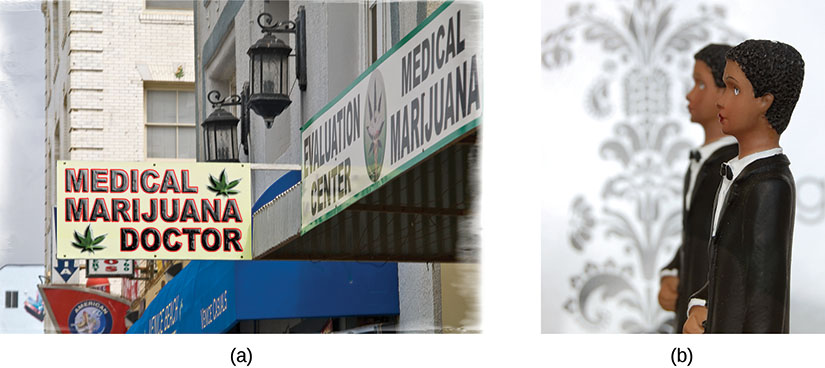Chapter 2: The Constitution and Its Origins
The Development of the Constitution
Learning Objectives
By the end of this section, you will be able to:
- Identify the conflicts present and the compromises reached in drafting the Constitution
- Summarize the core features of the structure of U.S. government under the Constitution
In 1786, Virginia and Maryland invited delegates from the other eleven states to meet in Annapolis, Maryland, for the purpose of revising the Articles of Confederation. However, only five states sent representatives. Because all thirteen states had to agree to any alteration of the Articles, the convention in Annapolis could not accomplish its goal. Two of the delegates, Alexander Hamilton and James Madison, requested that all states send delegates to a convention in Philadelphia the following year to attempt once again to revise the Articles of Confederation. All the states except Rhode Island chose delegates to send to the meeting, a total of seventy men in all, but many did not attend. Among those not in attendance were John Adams and Thomas Jefferson, both of whom were overseas representing the country as diplomats. Because the shortcomings of the Articles of Confederation proved impossible to overcome, the convention that met in Philadelphia in 1787 decided to create an entirely new government.
POINTS OF CONTENTION
Fifty-five delegates arrived in Philadelphia in May 1787 for the meeting that became known as the Constitutional Convention. Many wanted to strengthen the role and authority of the national government but feared creating a central government that was too powerful. They wished to preserve state autonomy, although not to a degree that prevented the states from working together collectively or made them entirely independent of the will of the national government. While seeking to protect the rights of individuals from government abuse, they nevertheless wished to create a society in which concerns for law and order did not give way in the face of demands for individual liberty. They wished to give political rights to all free men but also feared mob rule, which many felt would have been the result of Shays’ Rebellion had it succeeded. Delegates from small states did not want their interests pushed aside by delegations from more populous states like Virginia. And everyone was concerned about slavery. Representatives from southern states worried that delegates from states where it had been or was being abolished might try to outlaw the institution. Those who favored a nation free of the influence of slavery feared that southerners might attempt to make it a permanent part of American society. The only decision that all could agree on was the election of George Washington, the former commander of the Continental Army and hero of the American Revolution, as the president of the convention.
The Question of Representation: Small States vs. Large States
One of the first differences among the delegates to become clear was between those from large states, such as New York and Virginia, and those who represented small states, like Delaware. When discussing the structure of the government under the new constitution, the delegates from Virginia called for a bicameral legislature consisting of two houses. The number of a state’s representatives in each house was to be based on the state’s population. In each state, representatives in the lower house would be elected by popular vote. These representatives would then select their state’s representatives in the upper house from among candidates proposed by the state’s legislature. Once a representative’s term in the legislature had ended, the representative could not be reelected until an unspecified amount of time had passed.
Delegates from small states objected to this Virginia Plan. Another proposal, the New Jersey Plan, called for a unicameral legislature with one house, in which each state would have one vote. Thus, smaller states would have the same power in the national legislature as larger states. However, the larger states argued that because they had more residents, they should be allotted more legislators to represent their interests (Figure).

Figure 1. The Virginia Plan called for a two-house legislature. Representation in both houses would be based on population. A state’s representatives in one house would be elected by the state’s voters. These representatives would then appoint representatives to the second house from among candidates chosen by the state’s legislature. The New Jersey Plan favored maintaining a one-house Congress with each state being equally represented.
Slavery and Freedom
Another fundamental division separated the states. Following the Revolution, some of the northern states had either abolished slavery or instituted plans by which slaves would gradually be emancipated. Pennsylvania, for example, had passed the Act for the Gradual Abolition of Slavery in 1780. All people born in the state to enslaved mothers after the law’s passage would become indentured servants to be set free at age twenty-eight. In 1783, Massachusetts had freed all enslaved people within the state. Many Americans believed slavery was opposed to the ideals stated in the Declaration of Independence. Others felt it was inconsistent with the teachings of Christianity. Some feared for the safety of the country’s white population if the number of slaves and white Americans’ reliance on them increased. Although some southerners shared similar sentiments, none of the southern states had abolished slavery and none wanted the Constitution to interfere with the institution. In addition to supporting the agriculture of the South, slaves could be taxed as property and counted as population for purposes of a state’s representation in the government.
Federal Supremacy vs. State Sovereignty
Perhaps the greatest division among the states split those who favored a strong national government and those who favored limiting its powers and allowing states to govern themselves in most matters. Supporters of a strong central government argued that it was necessary for the survival and efficient functioning of the new nation. Without the authority to maintain and command an army and navy, the nation could not defend itself at a time when European powers still maintained formidable empires in North America. Without the power to tax and regulate trade, the government would not have enough money to maintain the nation’s defense, protect American farmers and manufacturers from foreign competition, create the infrastructure necessary for interstate commerce and communications, maintain foreign embassies, or pay federal judges and other government officials. Furthermore, other countries would be reluctant to loan money to the United States if the federal government lacked the ability to impose taxes in order to repay its debts. Besides giving more power to populous states, the Virginia Plan also favored a strong national government that would legislate for the states in many areas and would have the power to veto laws passed by state legislatures.
Others, however, feared that a strong national government might become too powerful and use its authority to oppress citizens and deprive them of their rights. They advocated a central government with sufficient authority to defend the nation but insisted that other powers be left to the states, which were believed to be better able to understand and protect the needs and interests of their residents. Such delegates approved the approach of the New Jersey Plan, which retained the unicameral Congress that had existed under the Articles of Confederation. It gave additional power to the national government, such as the power to regulate interstate and foreign commerce and to compel states to comply with laws passed by Congress. However, states still retained a lot of power, including power over the national government. Congress, for example, could not impose taxes without the consent of the states. Furthermore, the nation’s chief executive, appointed by the Congress, could be removed by Congress if state governors demanded it.
Individual Liberty vs. Social Stability
The belief that the king and Parliament had deprived colonists of their liberties had led to the Revolution, and many feared the government of the United States might one day attempt to do the same. They wanted and expected their new government to guarantee the rights of life, liberty, and property. Others believed it was more important for the national government to maintain order, and this might require it to limit personal liberty at times. All Americans, however, desired that the government not intrude upon people’s rights to life, liberty, and property without reason.
COMPROMISE AND THE CONSTITUTIONAL DESIGN OF AMERICAN GOVERNMENT
Beginning in May 1787 and throughout the long, hot Philadelphia summer, the delegations from twelve states discussed, debated, and finally—after compromising many times—by September had worked out a new blueprint for the nation. The document they created, the U.S. Constitution, was an ingenious instrument that allayed fears of a too-powerful central government and solved the problems that had beleaguered the national government under the Articles of Confederation. For the most part, it also resolved the conflicts between small and large states, northern and southern states, and those who favored a strong federal government and those who argued for state sovereignty.
The Great Compromise
The Constitution consists of a preamble and seven articles. The first three articles divide the national government into three branches—Congress, the executive branch, and the federal judiciary—and describe the powers and responsibilities of each. In Article I, ten sections describe the structure of Congress, the basis for representation and the requirements for serving in Congress, the length of Congressional terms, and the powers of Congress. The national legislature created by the article reflects the compromises reached by the delegates regarding such issues as representation, slavery, and national power.
After debating at length over whether the Virginia Plan or the New Jersey Plan provided the best model for the nation’s legislature, the framers of the Constitution had ultimately arrived at what is called the Great Compromise, suggested by Roger Sherman of Connecticut. Congress, it was decided, would consist of two chambers: the Senate and the House of Representatives. Each state, regardless of size, would have two senators, making for equal representation as in the New Jersey Plan. Representation in the House would be based on population. Senators were to be appointed by state legislatures, a variation on the Virginia Plan. Members of the House of Representatives would be popularly elected by the voters in each state. Elected members of the House would be limited to two years in office before having to seek reelection, and those appointed to the Senate by each state’s political elite would serve a term of six years.
Congress was given great power, including the power to tax, maintain an army and a navy, and regulate trade and commerce. Congress had authority that the national government lacked under the Articles of Confederation. It could also coin and borrow money, grant patents and copyrights, declare war, and establish laws regulating naturalization and bankruptcy. While legislation could be proposed by either chamber of Congress, it had to pass both chambers by a majority vote before being sent to the president to be signed into law, and all bills to raise revenue had to begin in the House of Representatives. Only those men elected by the voters to represent them could impose taxes upon them. There would be no more taxation without representation.
The Three-Fifths Compromise and the Debates over Slavery
The Great Compromise that determined the structure of Congress soon led to another debate, however. When states took a census of their population for the purpose of allotting House representatives, should slaves be counted? Southern states were adamant that they should be, while delegates from northern states were vehemently opposed, arguing that representatives from southern states could not represent the interests of enslaved people. If slaves were not counted, however, southern states would have far fewer representatives in the House than northern states did. For example, if South Carolina were allotted representatives based solely on its free population, it would receive only half the number it would have received if slaves, who made up approximately 43 percent of the population, were included.[1]
The Three-Fifths Compromise, illustrated in (Figure), resolved the impasse, although not in a manner that truly satisfied anyone. For purposes of Congressional apportionment, slaveholding states were allowed to count all their free population, including free African Americans and 60 percent (three-fifths) of their enslaved population. To mollify the north, the compromise also allowed counting 60 percent of a state’s slave population for federal taxation, although no such taxes were ever collected. Another compromise regarding the institution of slavery granted Congress the right to impose taxes on imports in exchange for a twenty-year prohibition on laws attempting to ban the importation of slaves to the United States, which would hurt the economy of southern states more than that of northern states. Because the southern states, especially South Carolina, had made it clear they would leave the convention if abolition were attempted, no serious effort was made by the framers to abolish slavery in the new nation, even though many delegates disapproved of the institution.

Figure 2. This infographic shows the methods proposed for counting slave populations and the resulting Three-Fifths Compromise.
Indeed, the Constitution contained two protections for slavery. Article I postponed the abolition of the foreign slave trade until 1808, and in the interim, those in slaveholding states were allowed to import as many slaves as they wished.[2]
Furthermore, the Constitution placed no restrictions on the domestic slave trade, so residents of one state could still sell enslaved people to other states. Article IV of the Constitution—which, among other things, required states to return fugitives to the states where they had been charged with crimes—also prevented slaves from gaining their freedom by escaping to states where slavery had been abolished. Clause 3 of Article IV (known as the fugitive slave clause) allowed slave owners to reclaim their human property in the states where slaves had fled.[3]
Separation of Powers and Checks and Balances
Although debates over slavery and representation in Congress occupied many at the convention, the chief concern was the challenge of increasing the authority of the national government while ensuring that it did not become too powerful. The framers resolved this problem through a separation of powers, dividing the national government into three separate branches and assigning different responsibilities to each one, as shown in (Figure). They also created a system of checks and balances by giving each of three branches of government the power to restrict the actions of the others, thus requiring them to work together.

Figure 3. To prevent the national government, or any one group within it, from becoming too powerful, the Constitution divided the government into three branches with different powers. No branch could function without the cooperation of the others, and each branch could restrict the powers of the others.
Congress was given the power to make laws, but the executive branch, consisting of the president and the vice president, and the federal judiciary, notably the Supreme Court, were created to, respectively, enforce laws and try cases arising under federal law. Neither of these branches had existed under the Articles of Confederation. Thus, Congress can pass laws, but its power to do so can be checked by the president, who can veto potential legislation so that it cannot become a law. Later, in the 1803 case of Marbury v. Madison, the U.S. Supreme Court established its own authority to rule on the constitutionality of laws, a process called judicial review.
Other examples of checks and balances include the ability of Congress to limit the president’s veto. Should the president veto a bill passed by both houses of Congress, the bill is returned to Congress to be voted on again. If the bill passes both the House of Representatives and the Senate with a two-thirds vote in its favor, it becomes law even though the president has refused to sign it.
Congress is also able to limit the president’s power as commander-in-chief of the armed forces by refusing to declare war or provide funds for the military. To date, the Congress has never refused a president’s request for a declaration of war. The president must also seek the advice and consent of the Senate before appointing members of the Supreme Court and ambassadors, and the Senate must approve the ratification of all treaties signed by the president. Congress may even remove the president from office. To do this, both chambers of Congress must work together. The House of Representatives impeaches the president by bringing formal charges against him or her, and the Senate tries the case in a proceeding overseen by the Chief Justice of the Supreme Court. The president is removed from office if found guilty.
According to political scientist Richard Neustadt, the system of separation of powers and checks and balances does not so much allow one part of government to control another as it encourages the branches to cooperate. Instead of a true separation of powers, the Constitutional Convention “created a government of separated institutions sharing powers.”[4]
For example, knowing the president can veto a law he or she disapproves, Congress will attempt to draft a bill that addresses the president’s concerns before sending it to the White House for signing. Similarly, knowing that Congress can override a veto, the president will use this power sparingly.
Federal Power vs. State Power
The strongest guarantee that the power of the national government would be restricted and the states would retain a degree of sovereignty was the framers’ creation of a federal system of government. In a federal system, power is divided between the federal (or national) government and the state governments. Great or explicit powers, called enumerated powers, were granted to the federal government to declare war, impose taxes, coin and regulate currency, regulate foreign and interstate commerce, raise and maintain an army and a navy, maintain a post office, make treaties with foreign nations and with Native American tribes, and make laws regulating the naturalization of immigrants.
All powers not expressly given to the national government, however, were intended to be exercised by the states. These powers are known as reserved powers (Figure). Thus, states remained free to pass laws regarding such things as intrastate commerce (commerce within the borders of a state) and marriage. Some powers, such as the right to levy taxes, were given to both the state and federal governments. Both the states and the federal government have a chief executive to enforce the laws (a governor and the president, respectively) and a system of courts.

Figure 4. Reserve powers allow the states to pass intrastate legislation, such as laws on commerce, drug use, and marriage (a). However, sometimes judicial rulings at the federal level may supersede such legislation, as happened in Obergefell v. Hodges (2015), the recent Supreme Court case regarding marriage equality (b). (credit a: modification of work by Damian Gadal; credit b: modification of work by Ludovic Bertron)
Although the states retained a considerable degree of sovereignty, the supremacy clause in Article VI of the Constitution proclaimed that the Constitution, laws passed by Congress, and treaties made by the federal government were “the supreme Law of the Land.” In the event of a conflict between the states and the national government, the national government would triumph. Furthermore, although the federal government was to be limited to those powers enumerated in the Constitution, Article I provided for the expansion of Congressional powers if needed. The “necessary and proper” clause of Article I provides that Congress may “make all Laws which shall be necessary and proper for carrying into Execution the foregoing [enumerated] Powers, and all other Powers vested by this Constitution in the Government of the United States, or in any Department or Officer thereof.”
The Constitution also gave the federal government control over all “Territory or other Property belonging to the United States.” This would prove problematic when, as the United States expanded westward and population growth led to an increase in the power of the northern states in Congress, the federal government sought to restrict the expansion of slavery into newly acquired territories.
Summary
Realizing that flaws in the Articles of Confederation could harm the new country and recognizing that the Articles could not easily be revised as originally intended, delegates from the states who met in Philadelphia from May through September 1787 set about drafting a new governing document. The United States that emerged from the Constitutional Convention in September was not a confederation, but it was a republic whose national government had been strengthened greatly. Congress had been transformed into a bicameral legislature with additional powers, and a national judicial system had been created. Most importantly, a federal system had been established with the power to govern the new country.
To satisfy the concerns of those who feared an overly strong central government, the framers of the Constitution created a system with separation of powers and checks and balances. Although such measures satisfied many, concerns still lingered that the federal government remained too powerful.
| NOTE: The activities below will not be counted towards your final grade for this class. They are strictly here to help you check your knowledge in preparation for class assignments and future dialogue. Best of luck! |
Glossary
- bicameral legislature
- a legislature with two houses, such as the U.S. Congress
- checks and balances
- a system that allows one branch of government to limit the exercise of power by another branch; requires the different parts of government to work together
- enumerated powers
- the powers given explicitly to the federal government by the Constitution (Article I, Section 8); power to regulate interstate and foreign commerce, raise and support armies, declare war, coin money, and conduct foreign affairs
- federal system
- a form of government in which power is divided between state governments and a national government
- Great Compromise
- a compromise between the Virginia Plan and the New Jersey Plan that created a two-house Congress; representation based on population in the House of Representatives and equal representation of states in the Senate
- New Jersey Plan
- a plan that called for a one-house national legislature; each state would receive one vote
- reserved powers
- any powers not prohibited by the Constitution or delegated to the national government; powers reserved to the states and denied to the federal government
- separation of powers
- the sharing of powers among three separate branches of government
- supremacy clause
- the statement in Article VI of the Constitution that federal law is superior to laws passed by state legislatures
- Three-Fifths Compromise
- a compromise between northern and southern states that called for counting of all a state’s free population and 60 percent of its slave population for both federal taxation and representation in Congress
- unicameral legislature
- a legislature with only one house, like the Confederation Congress or the legislature proposed by the New Jersey Plan
- veto
- the power of the president to reject a law proposed by Congress
- Virginia Plan
- a plan for a two-house legislature; representatives would be elected to the lower house based on each state’s population; representatives for the upper house would be chosen by the lower house

